Thanks, Ana
Bob Hoff
Note: October 5, 2007--I just called Dale Pate about some information and we were discussing this post. I misunderstood what he said about the following pictures were when he gave them to me. I thought that these rocks were from the original rock fall. Instead they may be rocks dislodged during "cleaning up," that if I understand it correctly now, fell in a different section of the cave than at the rock fall site.
When Dale gets back from his upcoming trip, he will look up the real rock fall pictures and I will substitute the correct photos when I receive them. Sorry for the misinformation.
This post was originally published 9/28/07.
Bob
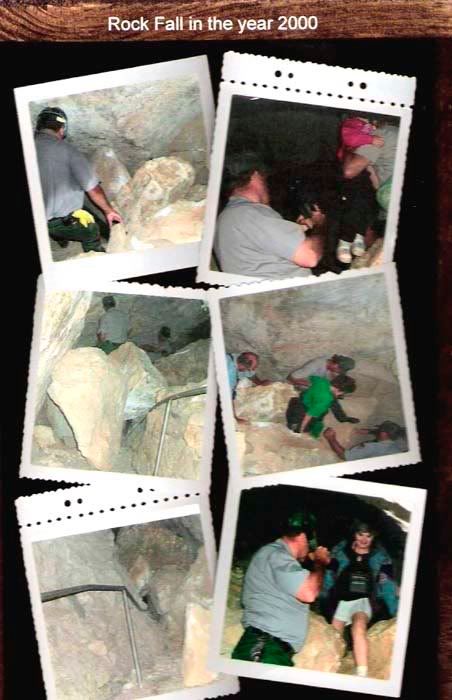
October 10, 2007--Pictures Added: Here is a one page of Rock Fall 2000 pictures that was included in a book of cavern memories that was put together for me in early 2005 when I retired from the caverns.
Employees assisting visitors.
**********************************************************************************
Sometime between the evening-morning period of June 25 - 26, 2000, when the Carlsbad Caverns was closed to visitation, "a significant rock fall occurred in the vicinity of Iceberg Rock in the Main Corridor. An estimated three cubic yards of cave rock material had fallen, enough to almost entirely block the visitor trail and so the trail was closed and removal of the rock debris was begun.
Several employees responded to the scene and what they saw astonished them.
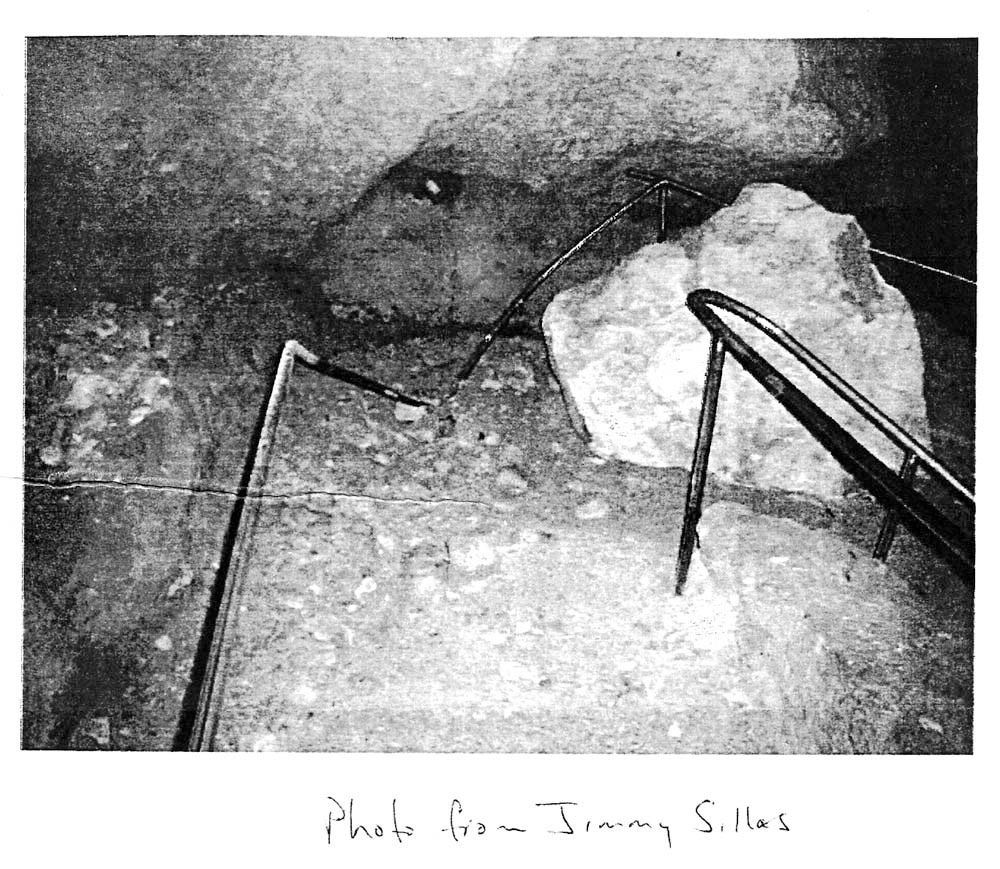
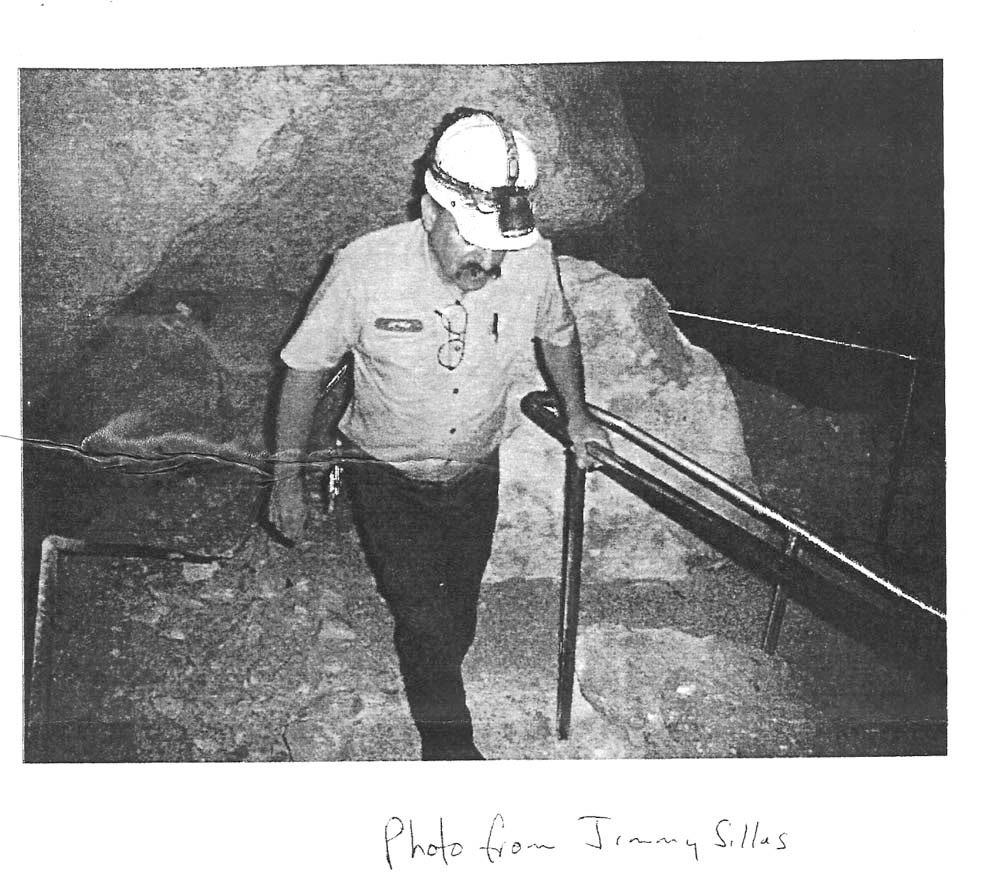
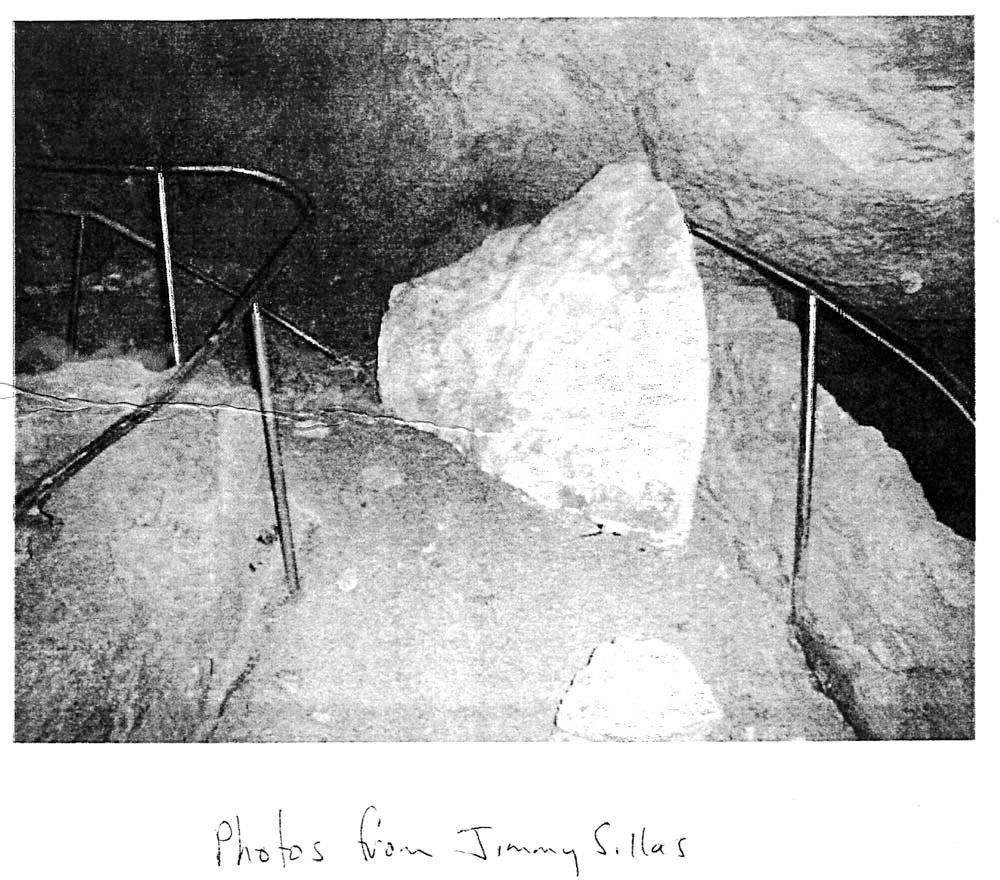
These three photos were taken by Maintenance Division Supervisor Jimmy Sillas.
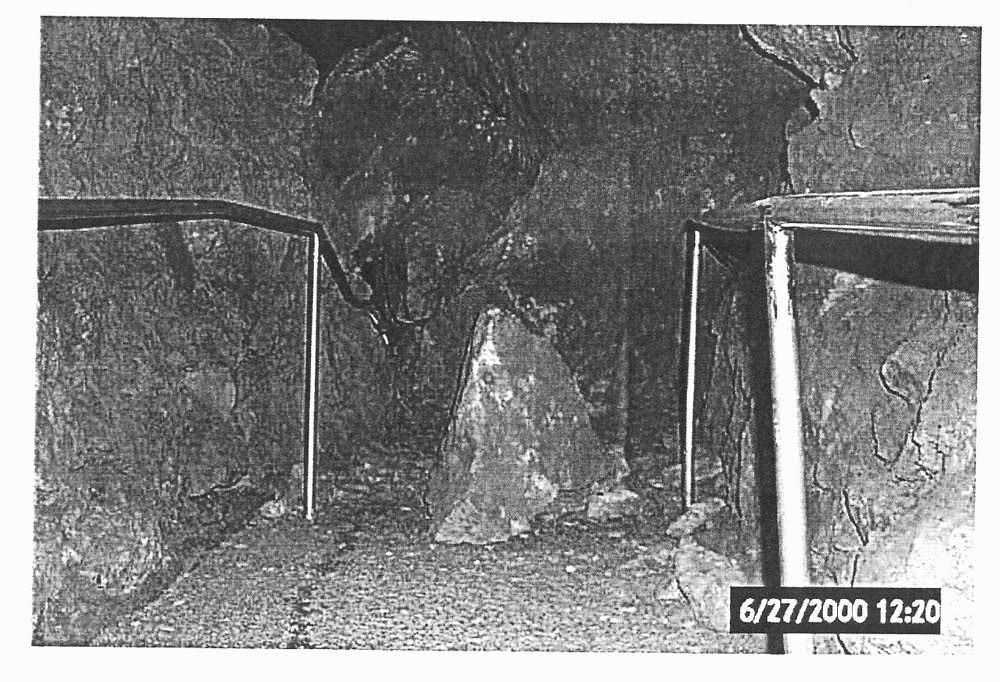
This photo was taken by NPS Cultural Resources Division employee Fred MacVaugh
A briefing statement was issued allmost immediately.
At 10:45 a.m., Staff Briefing Statement No. 1 on the Main Corridor Rock Fall was issued. Here it follows:
Date: 06/26/2000 12:34 PM
Sender: Dianne White
To: #CAVE Nodes; Stan Allison; Myra Barnes; Frosty Bennett; Renee
Beymer; Paul Burger; CAVE Acting Superintendent; CAVE RM&VP; Jim
Cheatham; Diane Dobos-Bubno; Patty Fugate; Liz Miller; Dale Pate;
Jason Richards; Dave Roemer; Gary Vequist
Priority: Normal
Subject: Rockslide
Staff Briefing Statement No. 1
Main Corridor Rock Fall
Carlsbad Caverns National Park
26 June 2000 1045hrs
At approximately 0845 hours on June 26, 2000, a Park Ranger reported that rocks had fallen in the vicinity of Iceberg Rock and that there was enough material to block the trail to visitors. Supervisory Rangers, Maintenance and Cave Resource Specialists went to the scene and discovered a rock fall of approximately three (3) cubic yards that had fallen on the trail. The trail is sufficiently blocked to prevent passage without assistance, however approximately fifty (50) visitors who were already in the cave were able to pass without difficulty with the assistance of Rangers and Maintenance staff.
The rock fall is on the underside of Iceberg Rock, approximately ( ) mile in from the Natural Entrance on the self-guided Natural Entrance trail, just above the overlook into the Green Lake Room. The debris field is approximately sixteen (16) feet long and contains five major boulders and several smaller ones. The largest rock is approximately 6 feet tall and weighs approximately 2-3 tons. The trail was immediately closed to visitors at the initial notification, and it will remain closed until a thorough assessment can be made and cleanup completed. We anticipate that the area may be closed for several days, perhaps up to a week and will issue additional briefing statements as conditions change. Visitors will still have access to the Big Room, the Kings Palace Tour and the off-trail caving tours.
Caves are inherently stable environments with relatively constant temperatures and humidity, and only minimal air movement due to temperature differentials with the outside air. Conditions that cause rock fall on the surface, such as erosion or the freeze-thaw cycle, do not occur in caves except near cave entrances. Therefore, rock fall in the interior of caves like Carlsbad Caverns is an extremely rare event. A geologist from the nearby Waste Isolation Pilot Project (WIPP) will be assisting NPS Cave Specialists in investigating the cause of this fall and assessing the area for visitor and employee safety. Their inspection will cover the rest of the cave trails, as well, to insure that no other problems exist. Cleanup will begin and the area will be reopened as soon as the job can be safely completed.
More briefings were issued during the day as cleanup operations began in anticipation of opeing the caverns back up to operations in the days ahead. On July 19, 2000, Mining Engineering Philip Cloues of the National Park Service Mining Operations Branch in Denver visited to perform a Geohazards Inspection. He wrote his trip report on February 15, 2001:
United States Department of the Interior
NATIONAL PARK SERVICE
Geologic Resources Division
P.O. Box 2287
Denver, CO 8022
IN REPLY REFER T0:
L3023 (2360) February 15, 2001
To: Chief, Mineral Operations Branch, Geologic Resources Division (GRD)
From: Mining Engineer, Mineral Operations Branch, GRD (Philip Cloues)
Subject: Trip Report, Geohazards at Carlsbad Caverns National Park, July 19, 2000
Background - The Ranger Report of June 29, 2000 carried Incident Report 00-3I7 (Carlsbad Caverns NP [NM] - Follow-up on Rock Fall. "Rangers discovered a significant rock fall in the vicinity of Iceberg Rock on the morning of June 26th. Enough material - about three cubic yards of rock - had fallen to block almost entirely the trail to visitors and it was accordingly closed. Removal of the rock is now underway. ... With luck, the debris will be remove and the trail reopened by Sunday. “Returning to the office on June 218 from the Colorado Mine Land Reclamation Division's biannual advisory meeting in Steamboat Springs, Colorado, I discussed a possible site inspection trip with Gary Vequist of the park's staff.
Cave Geohazard Assessment - I arrived at the park on July 19, 2000 and visited the location of the rock-fall accompanied by Dale Pate (Cave Resource Specialist), Paul Berger (Cave Resource Specialist and geological engineer), and Ruben Castillo (Maintenance Foreman). The trail had been reopened and clean up completed of all fallen rock debris. The collapse was not associated with inplace native rock. The area of the rock fall is in a tunnel created by the Civilian Conservation Corp (CCC) in the early 1930'x, which goes around Iceberg Rock. The new trail eliminated the rickety wooden staircase access. The hand-stacked rock was probably disturbed over a period of 70 years from normal settling and periodic foot traffic to change light bulbs that were located in the overhead vicinity. The fall occurred in a dark tunnel area that was poorly lighted. The rock-fall, the clean-up operations, and the removal of the light fixture to a more stable area have corrected the problem. I saw no areas of apparent unstable stacked rock within the immediate area.
Just a little further down trail at the Green Lake Room sign overlook switchback, there is an area of fractured inplace rock that merits maintenance attention. A discussion within the group concluded that rock and mortar (grout) support should be provided to reduce the uncertainty of possible future collapse. The recommended work conforms to other typical trail maintenance projects and would blend with the natural form of the cave wall. This particular area has undergone a combination of natural cave processes of dissolution and fracturing. However, the work of the CCC (e.g., a possibility of explosives having been used for the tunnel work nearby) probably contributed to crack propagation at the switchback from excessive vibration. The presence of Iceberg Rock in its present location is proof enough that collapse is a cave forming process.
While the majority of my experience of assessing rock failure has been associated with mined openings, this particular rock failure (June 26, 2000) falls into that category and not one of normal cave development processes. Historic tampering of cave trails and passages through excavation were often poorly documented and recorded. While that practice now receives detailed scrutiny, past practice often went heavy on the blasting and lacked present day monitoring with vibration detectors. Overall, I felt a level of comfort walking through the cave that is appropriate for solution caves. While there is always risk of the unexpected, I saw no other readily apparent concerns from any geohazard while underground.
Conclusions - I believe that the rock-fall was the result of long term settling of hand-placed rock that had been altered from its original placement within the virgin cave. The actual cause of the triggering of the event can only be speculated to no purpose. What is important is a reminder that there are risks associated with subsurface openings and that everyone should keep an eye open for rock on the trail that may be a precursor to a larger event if left unattended. Maintenance logs are a method of tracking, over time, the changes associated with rock movement. Periodic inspections by a trained geologist, geological engineer, mining engineer. rock mechanics engineer or person of similar expertise is another tool to lessen the risk of unexpected geohazard events.
Surface Inspection - I accompanied Ruben Castillo to inspect two areas of concern along the road to the cave facility. These areas are referred to as Big Hill and Shady Rest. Both areas have unstable, fractured rock that will eventually fail and collapse. The proximate location of the road creates a potential risk of harm to vehicular traffic. Freeze and thaw cycles (i.e., frost wedging), rain, heat generated crack expansion, root penetration, and gravity are at work to reduce the near vertical walls of the road cut by mass wasting. I concur with Ruben Castillo that a planned maintenance project to control the time of the eventual collapse event is preferable to an unscheduled one. Both areas are high risk for failure at any time and should be scheduled as a preventive maintenance project to address the problem. I would recommend that the park maintenance staff conduct an on site inspection with a State highway goo-technician to aid in determining the areas of highest risk before rock removal commences. The natural springs in the Big Hill area are especially a contributing factor to the deterioration of the rock face. Ruben is aware of the specific areas of concern that need attention and mentioned that this type of maintenance has been successfully accomplished in the past.
Summary - The size of the rock-fall near Iceberg Rock was alarming. It demonstrated that the forces of nature are always present and that we must maintain a vigilance of alertness. Overall, the vast majority of rock within Carlsbad Caverns is stable. Nevertheless, large rooms that show rock-fall on the floor from natural collapse demonstrate that uncertainty does exist as to the long-term stability. Walking through the cave is statistically safer than driving to the park. But, occasionally there will be a rock-fall. While the cave opening exposed to the elements is most vulnerable, there appeared no detectable areas of concern. The exposure rate (that point in time of a rock-fall event in which a person is directly under that rock) is statistically small, the incidents are statistically small, and the history to date indicates a reasonably safe environment within the areas accessed by visitors and staff. Because of the great heights within the caverns, it is impossible to know with absolute assurance through visual inspection and sounding that the ceiling is 100% safe. However, I would not hesitate to go on a tour of the caverns with my grandchildren. I believe that the risk of a mishap from a geohazard approaches zero when compared to other risks that we face in our everyday world (e.g., tripping hazards, car accidents, disease, food poisoning, getting lost, sun stroke, contaminated water, drowning, dog bites, snake bites, etc.).
Please contact me at 303-969-2148 if you have any questions concerning this trip report. Your geological engineer, Paul Burger, could be a valuable tool to assist the park staff in an ongoing program of geohazard assessment.
cc. Superintendent, Carlsbad Caverns NP
In February 2007, park interpreter Greg Litten sought to clarify for the historical record what had "really" happened in June 2000.
From The Cavern Speaks #4
Winter/Spring 2007
What's the real deal with "Clorinda's Blockage?"
By Greg Litten, CAVE Park Interpreter
Sometime, somehow, somewhere in the past years, there has been quite a mixing of truth and guesswork, and in addition, legend regarding the biggest geologic event inside the cave in recorded human history. For a refresher, here is the scoop...
Note: Photo and Diagram associated with this information would not scan
The Bare Bone Facts (Bones or Stones?)
--Three large limestone boulders and debris fell onto the Natural Entrance trail sometime between Main Corridor sweep on June 25t' and Main Corridor lights on June 26th, 2000.
--These boulders landed about 3‑15 feet upslope of the shell fossil in "Pee" Alley and bent the handrail to the trail.
--Boulders #1 and #2 were the biggest, boulder #3 was 2/3 size of #1
--A newly formed "gap" in the "Pee" Alley ceiling / overhang was exposed.
--Seasonal Park Guide Clorinda Maidonardo was doing MC lights on June 26th and reported via the Iceberg Rock phone at about 8:45 a. m. that "there were some rocks on the trail. Ranger Sam Franco was acting and he closed the Main Corridor by 9:00 a.m.
--The Main Corridor was closed for two or three days as the three boulders were broken apart by drilling into them and the resulting pieces subsequently being relocated.
--Hundreds of feet downhill from "Clorinda's Blockage", lack repair patches on the Main Corridor trail still show places where the broken-apart boulder fragments damaged the trail while being moved away by the NPS crew.
--The vacuuming of cave trails was not going on in the week prior to the event.
--Seasonal Park Guide Ray Beardsley and Ranger Paula Carrington had seen small softball sized rocks on that section of trail in the weeks beforehand.
--Rock #2 bent the handrail almost to the trail. Several wires from compact fluorescent light bulbs were dangling about in the "gap"10‑feet above trail where rocks fell.
--NPS maintenance Light technician Alvino Dorado had not changed the bulbs in the lights on top on the "Pee" Alley breakdown for months before the rock fall. He recalls, "That hard packed dirt filled in the spaces on top of the rocks" that fell.
To: Greg Litten/CAVE/NPS@NPS
From: Dale Pate/CAVE/NPS
Date: 02/09/2007 09:07AM
Subject: Clorinda's Blockage
Hi Greg,
I read with interest your article in "The Cavern Speaks" titled What's the real deal with "Clorinda's Blockage? I share your interest in providing accurate information and wanted to provide you with a few tidbits and observations as well.
This incident occurred when I was at the NSS Convention (I believe the Convention was in West Virginia that year) and, of course, I had heard about the rock fall by phone from Paula B. on the evening of its discovery. The next day, a New Mexico caver at the convention came up to me reporting that she had just heard on the radio that the entrance to Carlsbad Cavern had collapsed and that visitors had been trapped inside. I explained the real incident to her, but was amazed that such totally incorrect information was being broadcast over the radio nationwide.
* Incident Report 00‑317 stated among other things the following: Enough material ‑about three cubic yards of rock ‑ had fallen to almost entirely block the trail.... Three cubic yards = 81 cubic feet (I think)
* Staff Briefing Statement No. 3 Issued on June 27 at 1600 hours states: Three representatives from WIPP, assisted by Jason Richards, Jimmy Sillas, and Alvino Dorado, removed the loose rocks from above the rockslide area this afternoon and the R& T crew immediately began removing the smaller pieces. The WIPP team's work probably doubled the amount of rock in the trail that will need to be moved.
* I coincidently ran into Jimmy Sillas a few moments ago. I asked him about the holes in the trail below the tunnel, thinking that they had been created when the WIPP team were cleaning rocks off of the top and some must had fallen off the edge that faces the Green Lake Room (which is directly over the trail where the holes in the trail that were patched are). Jimmy said though that the holes were there already when they came to begin cleanup and that they must have been created during the rock fall event.
I also asked Jimmy about how they broke up the larger rocks and he said that they ended up not needing to use the expanding form but had actually used what is known as drilling feathers and wedges that are inserted into a hole and then pounded on with hammers until the rock breaks. I notice in the Staff Briefing Statement No. 3 that it says that the big rocks will be broken up using expanding foam that would be injected into drilled holes. This briefing statement must have come out before they broke up the large rocks.
*Phillip Cloues, a mining engineer from the Mineral Operations Branch of the Geologic Resources Division (NPS) was brought to the park and inspected the rock fall area on July 19. In his report, he indicated "...the clean‑up operations and the removal of the light fixture to a more stable area have corrected the problem. / saw no areas of apparent unstable rock within the immediate area. "
It is interesting that you note "Seasonal Park Guide Ray Beardsley and Ranger Paula Carrington had seen small softball‑sized rocks on that section of trail in the weeks beforehand. Phil Cloues' report stated that for the future "... everyone should keep an eye open for rock on the trail that maybe a precursor to a larger event if left unattended.”
However, I would disagree that this was only a geologic event. While geological processes and gravity; have certainly played a significant role in this event (this is huge breakdown pile after all), the entire small area in the tunnel as well as on top where the light fixture was located has seen human manipulation and intervention since the discovery of this critical area of the cave. It is likely that Jim White's original route down to the Green Lake Room came down through the breakdown and large rocks just uphill from where the rock fall occurred and probably traveled between the large rocks where the trail goes now. When the wooden staircase was built to provide easier access down to the Green Lake Room, it was bolted in place directly above this area. Thousands of visitors walked above this route over a number of years. It is even possible that to clear and flattened the trail for this route, large rocks (such as the ones that finally fell) were pushed into the hole from above. And then, of course, the most serious human manipulation came to this small area when the route the trail follows now was blasted wide enough and deep enough to walk along. It only took another 60 or 70 years after this blasting for the rock fall to occur (a very short time geologically speaking).
So in summary, I would submit that we would be remiss in calling this simply "natural cave breakdown". While it is true that over time, this breakdown pile will continue to move downward due to natural processes, I do feel that the blasting and the general manipulation and visitation to this very critical, small area were major factors in this rock fall event.
I was thinking of going into the cave sometime after I am back from Washington DC (Paula and I go there next week before she flies off to France) to r look at the area. I need to do this particularly in light of the information Jimmy(Sillas) provided indicating that the holes in the trail below the tunnel must have been somehow created during the rock fall event. Would you be interested in going in to look at the area and discuss the event as well?
Dale
Thanks to Dale Pate for his help in providing copies of pertinent documents and for discussing the Rock Fall with me.
3 comments:
enjz
enjz
enjz
enjz
enjz
enjz
enjz
enjz
enjz
enjz
enjz
enjz
enjz
enjz
enjz
enjz
enjz
enjz
enjz
enjz
enjz
enjz
enjz
enjz
enjz
enjz
enjz
enjz
enjz
enjz
enjz
enjz
enjz
kyrie 6
yeezy 700
stone island t shirt
kd 12
supreme clothing
yeezys
longchamp outlet
kyrie 5 spongebob
off white nike
yeezy boost
cswkyh772mv
golden goose outlet
golden goose outlet
golden goose outlet
golden goose outlet
golden goose outlet
golden goose outlet
supreme outlet
golden goose outlet
golden goose outlet
golden goose outlet
Post a Comment